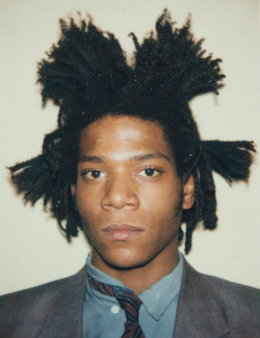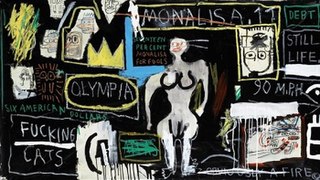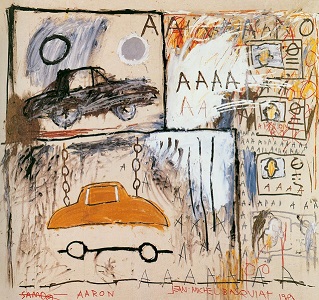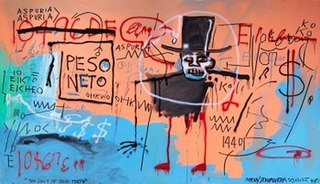
Jean-Michel Basquiat was an American artist who rose to success during the 1980s as part of the Neo-expressionism movement.

Fred Brathwaite, more popularly known as Fab 5 Freddy, is an American visual artist, filmmaker, and hip hop pioneer. He is considered one of the architects of the street art movement. Freddy emerged in New York's downtown underground creative scene in the late 1970s as a graffiti artist. He was the bridge between the burgeoning uptown rap scene and the downtown No Wave art scene. He was immortalized in 1981 when Debbie Harry rapped on the Blondie song "Rapture" that "Fab 5 Freddy told me everybody's fly." In the late 1980s, Freddy became the first host of the groundbreaking hip-hop music video show Yo! MTV Raps.
Rammellzee was a visual artist, gothic futurist "graffiti writer", painter, performance artist, art theoretician, sculptor and a hip hop musician from New York City, who has been cited as "instrumental in introducing elements of the avant-garde into hip-hop culture".
George Lee Quiñones is a Puerto Rican artist and actor. Quiñones rose to prominence by creating massive New York City subway car graffiti that carried his moniker "LEE". His style is rooted in popular culture and often with political messages.
Michael Thomas Holman is a New York-based artist, writer, filmmaker and musician. He is also an early 1980s downtown scene subculturalist and creator of the Hip Hop music program Graffiti Rock. Holman is a founding member, along with Jean-Michel Basquiat, of the experimental band Gray.
SAMO is a graffiti tag originally used on the streets of New York City from 1978 to 1980. The tag, written with a copyright symbol as "SAMO©", and pronounced Same-Oh, is primarily associated with the artist Jean-Michel Basquiat, but was originally developed as a collaboration between Basquiat and Al Diaz.
Gray is an American experimental band formed by artist Jean-Michel Basquiat and filmmaker Michael Holman in 1979, of whom filmmaker Vincent Gallo was also a member. The group was influenced by the members' artist backgrounds and the sonic experimentation of their contemporaries in New York's No Wave scene. Gray performed at venues such as the Mudd Club and CBGB which were the epicenter of New York's underground scene in the late 1970s and early 1980s.

A Panel of Experts is a painting created by American artist Jean-Michel Basquiat in 1982. The artwork in part is Basquiat's depiction of a catfight between two of his lovers, Suzanne Mallouk and singer Madonna.

Crown Hotel (Mona Lisa Black Background) is a 1982 painting created by American artist Jean-Michel Basquiat in 1982. The artwork cites Leonardo da Vinci's Mona Lisa and Édouard Manet's Olympia, two canonical works of western art. In June 2013, it sold for $7.4 million at Sotheby’s.
Torrick Ablack, also known as Toxic, is an American artist who was part of the graffiti movement of the early 1980s in New York City. He transitioned from street art to exhibiting his paintings in galleries and museums internationally.
Anthony Clark, known as A-One, was an American graffiti artist. He developed a style he called "aerosol expressionism".

Flesh and Spirit is a painting created by American artist Jean-Michel Basquiat c. 1982–83. The multi-panel painting, which is one of the largest ever made by Basquiat, sold for $30.7 million at Sotheby's in May 2018.

Untitled (Pollo Frito) is a painting created by American artist Jean-Michel Basquiat in 1982. The artwork was sold at Sotheby's for $25.7 million in November 2018.

Sabado por la Noche is a painting created by American artist Jean-Michel Basquiat in 1984. It sold for $10.7 million at Christie's in 2019.

Cadillac Moon is a painting created by American artist Jean-Michel Basquiat in 1981. It is notable for being the first purchased Basquiat painting; bought by singer Debbie Harry for $200.

Bird on Money is a 1981 painting created by American artist Jean-Michel Basquiat in 1981. It is a tribute to jazz musician Charlie Parker, who was nicknamed "Bird." The painting was acquired in 1981 and is housed in the Rubell Family Collection. In 2020, New York rock band the Strokes used the artwork as the cover for their studio album The New Abnormal.

Equals Pi is a painting created by American artist Jean-Michel Basquiat in 1982. The painting was published in GQ magazine in 1983 and W magazine in 2018.

The Guilt of Gold Teeth is a painting created by American artist Jean-Michel Basquiat in 1982. The painting, which depicts Baron Samedi, sold for $40 million at Christie's in November 2021.

Leonardo da Vinci's Greatest Hits is a painting created by American artist Jean-Michel Basquiat in 1982.












